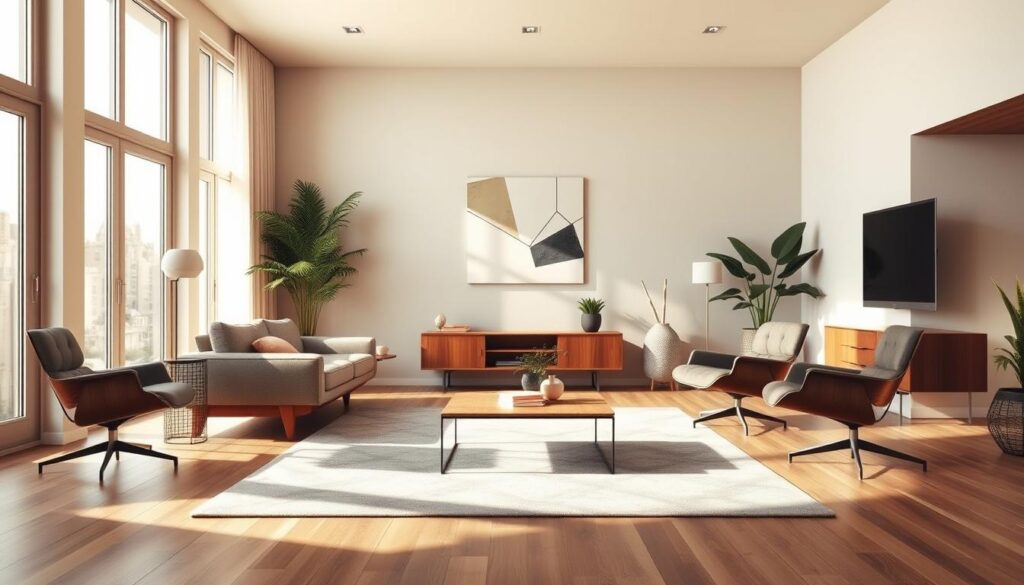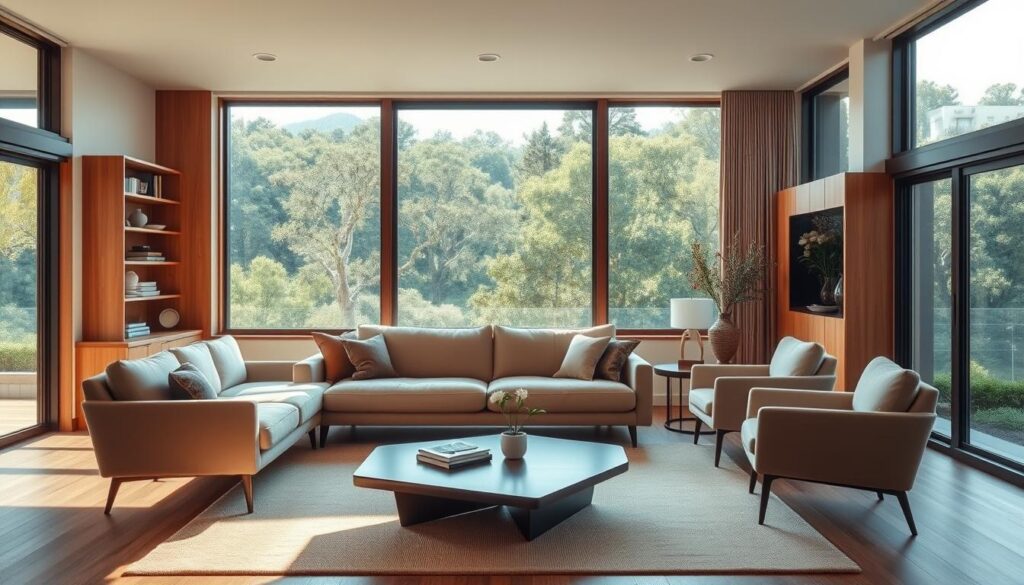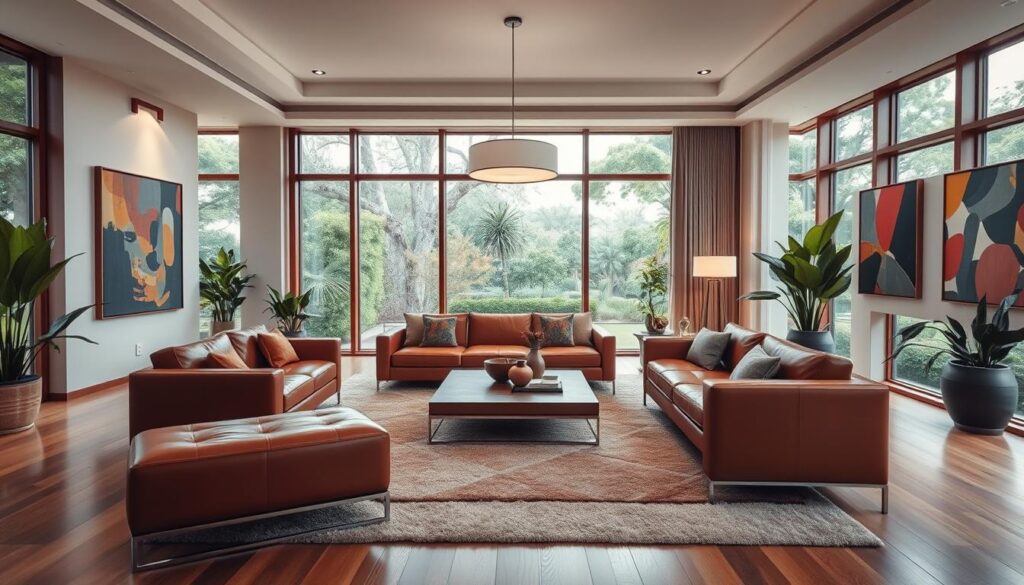Did you know that mid century modern design is still a top choice for home interiors? It’s known for its focus on function, simplicity, and blending with nature. This style keeps inspiring both homeowners and designers.
We’ll show you how to get a timeless mid century modern look in your home. We’ll cover furniture, colors, and how to arrange your space. Our guide aims to help you grasp the style’s essence and apply it to your home.
Key Takeaways
- Understanding the core principles of mid century modern design
- Selecting furniture that embodies the style
- Creating a harmonious color scheme
- Effective spatial planning for a seamless flow
- Incorporating natural elements into your decor
Understanding Mid Century Modern Design Principles
Mid century modern design is more than a trend. It’s a lifestyle that values simplicity and connects us to nature. This style has won over many with its mix of function, simplicity, and natural beauty.
Key Characteristics of Mid Century Modern Style
The mid century modern style stands out with clean lines, organic shapes, and a minimalist decor approach. It often includes large windows, open floor plans, and horizontal lines. This creates a sense of openness and smooth flow.
It also uses natural materials like wood, adding warmth and texture. Mixing wood with metal and glass creates interesting and dynamic spaces.
Importance of Functionality and Simplicity
Functionality and simplicity are key in mid century modern design. It focuses on practical living spaces where every piece has a purpose. The style aims for clean lines and minimal decoration, making spaces calm and efficient.
This design encourages a simpler way of living. It uses multi-functional furniture and plans spaces for beauty and usability.
The Role of Nature in Design
Nature is a big part of mid century modern design. It emphasizes bringing the outdoors in. Spaces often have large windows, sliding doors, and open areas that connect to gardens or outdoors.
This connection to nature improves a space’s look and feel. It also boosts our well-being and connection to the environment. Using natural materials and textures and adding plants further connects us to nature. Mid century modern design blends indoor and outdoor spaces smoothly.
Essential Elements of Mid Century Modern Homes
To create a mid century modern home, you need the right elements. We’ll look at key parts that make this style special. This will help you bring mid century modern design into your home.
Iconic Furniture Pieces We Should Consider
Mid century modern furniture is known for its sleek look and simple design. Pieces like the Eames Lounge Chair and Noguchi Coffee Table are essential. Choose furniture that is both beautiful and practical, like storage ottomans or sofas with simple designs.
For more ideas, check out Toll Brothers’ blog on mid century modern interior. It offers a detailed guide to the style.
Color Palettes That Define the Era
Mid century modern homes often use earthy tones and bold colors. You’ll see lots of green, blue, and yellow with neutral backgrounds. These colors create a perfect balance of warmth and coolness.
- Earthy tones like olive green and terracotta
- Bold accents such as turquoise and mustard yellow
- Neutral backgrounds including beige and gray
Incorporating Textures for Depth
Adding different textures is key to a mid century modern home. Use wood, leather, and metal to make your space interesting. For example, a wooden coffee table with leather chairs and metal lights adds depth.
By mixing these elements, you can make a stylish and welcoming mid century modern living room. Try out different textures and colors to find the perfect mix for your home.
Choosing the Right Materials for Interiors
Choosing the right materials is key to creating mid century modern interiors. We seek materials that match the era’s look and add to the space’s function and greenness.
Wood: The Heart of Mid Century Modern Homes
Wood is a must in mid century modern homes. It’s used for furniture, floors, and walls. Oak, walnut, and teak are favorites for their strength and beauty. Wood brings warmth and a natural feel to any room.
Glass and Metal Accents
Glass and metal add to the mid century modern look. Glass makes spaces feel open and airy. It’s used in furniture, lights, and decor. Metal, like brass or chrome, brings a sleek, modern touch.
- Glass reflects light, making rooms feel bigger and more connected.
- Metal accents add a touch of elegance and luxury.
Sustainable Materials for Modern Living
Using sustainable materials is now a big part of our design. Materials like reclaimed wood, bamboo, and eco-friendly paints are better for the planet. They also make our homes healthier.
- Reclaimed wood gives spaces history and cuts down on waste.
- Bamboo is a green choice for floors, furniture, and more.
- Low-VOC paints improve air quality, making homes healthier.
By picking materials that fit mid century modern style and using green practices, we make interiors that are stylish and eco-friendly.
Integrating Iconic Mid Century Modern Furniture
Adding iconic mid century modern furniture to your home can seem hard. But, with the right tips, it’s easy. This style is known for its clean lines, organic shapes, and usefulness. It’s a key part of modern home design.

How to Select Signature Pieces
Choosing key mid century modern furniture pieces means understanding the style’s basics. We seek items that show the era’s love for simplicity, usefulness, and blending with nature.
- Look for famous designs by Charles and Ray Eames, Eero Saarinen, and George Nelson.
- Choose items made from solid wood, glass, and metal, common in mid century modern furniture.
- Go for pieces with simple lines and little decoration.
Some must-have items include the Eames Lounge Chair, Saarinen’s Tulip Table, and Nelson’s Coconut Chair. These pieces are not just useful but also make a statement, showing off the mid century modern look.
Arranging Furniture for Flow and Functionality
After picking your key pieces, arranging them for flow and function is crucial. We suggest making a layout that encourages movement and talking.
- Begin by finding the room’s main focus, like a fireplace or big window, and place furniture around it.
- Make sure there’s a clear path through the room, avoiding mess and blocks.
- Use furniture to make different areas in the room, like a reading spot or dining area.
By carefully arranging your mid century modern furniture, you can make a space that’s both beautiful and useful. It will show off the style’s main ideas.
Lighting Solutions That Enhance the Style
The right lighting can make a mid century modern home feel warm and inviting. Lighting is not just for seeing; it’s a key part of the design. It can either enhance or detract from the style.
The Importance of Natural Light
Natural light is essential in mid century modern design. It lights up the space and connects it to the outdoors. To get more natural light, use sheer curtains or install skylights.
For more ideas on making your home cozy, check out our guide on captivating home interior ideas for a cozy retreat.
Benefits of Natural Light:
- Enhances the sense of space
- Reduces the need for artificial lighting
- Creates a warm and welcoming atmosphere
Fixture Styles That Fit the Aesthetic
Artificial lighting fixtures should match the mid century modern look. Look for clean lines, organic shapes, and a simple design. Sputnik chandeliers and globe pendant lights are popular choices.
Layered Lighting Approaches
Layered lighting uses different light sources to create a unique and functional space. This includes overhead lights, table lamps, and floor lamps. It helps achieve a balanced and dynamic atmosphere typical of mid century modern design.
Tips for Layered Lighting:
- Start with a primary light source, such as a ceiling fixture.
- Add task lighting, like under-cabinet lights or desk lamps.
- Use accent lighting to highlight architectural features or decorative elements.
Creating Open Spaces in Home Design
Creating open spaces in home design is more than just removing walls. It’s an art that makes living better. Open spaces are key in mid century modern homes. They bring unity and flow.
The Concept of Open Floor Plans
Open floor plans are a big part of mid century modern design. They remove walls to make spaces feel bigger. This helps family and guests talk and move around easily.
Open floor plans have many benefits:
- They let in more natural light.
- They improve how we interact with each other.
- They make it easier to arrange furniture.
Connecting Indoor and Outdoor Spaces
Mid century modern homes often mix indoor and outdoor spaces. They use big sliding glass doors and wide windows. This makes moving from inside to outside smooth.

The Use of Dividers and Partitions
Even with open floor plans, homes need different areas. Dividers and partitions help create these spaces without losing openness.
Here are some ways to use dividers:
| Divider Type | Purpose | Benefits |
|---|---|---|
| Sliding panels | Separate living areas | Flexible, easy to use |
| Room dividers with plants | Add greenery, define spaces | Enhance air quality, aesthetic appeal |
| Shelves | Display decor, separate areas | Storage, visual interest |
By using dividers and partitions smartly, homeowners get both open spaces and defined areas. This way, they can enjoy different activities in their home.
Color Schemes That Define Mid Century Modern Interiors
Mid century modern interiors are known for their careful color choices. This style, popular from the 1940s to the 1960s, uses bold yet balanced colors. These colors add warmth and character to any room.
The design of this era focused on being simple and functional. This is seen in its color schemes. Mid century modern color schemes mix earthy tones, brights, and neutrals. Together, they create a balanced look.
Popular Color Combinations from the Era
Some iconic color combos include olive green and terracotta with neutral backgrounds. These reflect the era’s love for nature. They also make spaces cozy and inviting.
- Earth tones with pops of bright colors
- Monochromatic schemes with varying shades of a single color
- Contrasting colors like blue and orange or red and green
Let’s look at these color combos in more detail:
| Color Combination | Description | Example |
|---|---|---|
| Earth Tones with Brights | Combining earthy tones like brown and beige with bright colors like yellow or orange. | A living room with a brown sofa, beige walls, and yellow accent pillows. |
| Monochromatic | Using different shades of the same color to create a cohesive look. | A bedroom with various shades of blue, from light sky blue to navy. |
| Contrasting Colors | Pairing colors that are opposite each other on the color wheel. | A kitchen with blue cabinets and orange accents. |
How to Incorporate Bold Accents
Bold accents are key in mid century modern design. Start by picking a bold piece, like a colorful rug or artwork. Then, build your color scheme around it.
For example, a bold red armchair can be balanced with neutral walls and floors. Add complementary colors with throw pillows and blankets.
The Role of Neutrals in Balancing Design
Neutral colors are essential in mid century modern design. They provide a calm background for bold accents. Neutrals like beige, gray, and white are common. They make spaces feel open and serene.
By mixing bold colors with neutral backgrounds, you create a harmonious space. This space captures the essence of mid century modern design.
Accessorizing with Mid Century Modern Decor
Accessorizing is key to making mid century modern homes lively and stylish. The right decor can make a space feel deeper and more personal, showing off the homeowner’s style.
Art that Resonates with the Style
Choosing art for mid century modern homes means looking for simplicity and organic shapes. Abstract art by artists like Jackson Pollock fits well with the era’s clean lines.
Here are tips for adding art:
- Go for bold colors or geometric patterns to catch the eye.
- Art that shows nature, like landscapes or plants, works well.
- Make sure the art fits the room and furniture.
Using Vintage Accessories Tastefully
Vintage accessories can make mid century modern decor feel more real. It’s important to use them tastefully to keep the style clean. Iconic vintage pieces like old lighting or decorations from the 50s and 60s can spark conversations.
Here’s how to use vintage items well:
- Choose a few standout pieces instead of many.
- Make sure vintage items match the style and don’t mess up the look.
- Blend vintage with modern for a balanced look.
Plants and Greenery for a Vibrant Touch
Adding plants and greenery can make mid century modern spaces lively. The era loved blending indoor and outdoor, making plants a perfect fit. Choose plants with interesting textures or shapes, like succulents or ferns, for a pop of interest.
“The way we live, the way we work, and the way we relax are all influenced by our surroundings. Bringing in elements of nature can significantly enhance our well-being.”
To add plants effectively:
- Pick plants that do well indoors and don’t need much care.
- Use planters that match the mid century modern look, like those with clean lines.
- Group plants for a lush feel or use them as solo pieces.
By carefully choosing art, vintage items, and plants, we can make mid century modern interiors that are stylish and full of character.
Tips for Maintaining Mid Century Modern Homes Interior
Keeping mid century modern homes looking great needs careful attention. We must keep their original charm while updating them. This balance is key.
Care for Iconic Pieces
Looking after mid century modern furniture is vital. Use soft cleaners and avoid harsh chemicals. This helps keep the furniture in top shape.
Preserving the Original Features
Wood paneling, big windows, and geometric patterns are essential. They keep the home’s mid century modern feel alive. Whenever possible, we should restore these features.
Update or Restore
Choosing between updating and restoring is important. Update what’s outdated, but restore what’s still good. This way, we keep our homes true to their mid century modern roots.


